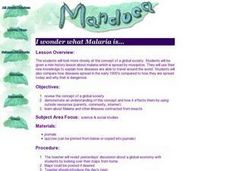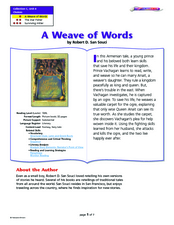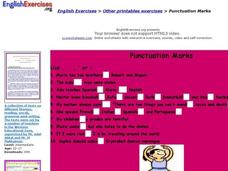American Museum of Natural History
Going, Going...Gone?
Young environmentalists consider how scientists are attempting to save endangered species. They read about what causes extinction and steps to take to minimize the threats.
Curated OER
Living With the Weather
Mini-meteorologists visit the National Climate Data Center online to gather past weather information for the area that they live in. They consider how the weather patterns may have influenced the architecture of the area. Finally, they...
Curated OER
I Wonder What Malaria is
Learners examine the disease malaria. They compare how diseases were spread in the early 1900's compared to how they are spread today and discuss why that is dangerous. They take a survey to see how much they know about insects that...
Perkins School for the Blind
The Function of Villi in the Small Intestine
Ever wonder what the villi in the small intestine do? I bet your class would love to find out. Mesh netting is used to represent small blood vessels on the outside of the intestine, and a chenille bath mat is used to represent the villi...
Curated OER
A Weave of Woods
Focus on vocabulary, comprehension, and analysis while reading A Weave of Woods, a colorful picture book by Robert D. San Souci. Young learners use worksheets to preview, predict, practice paraphrasing, and make comparisons. The...
Global Oneness Project
Reclaiming Rivers
Robert Hass's article "Rivers and Stories" underscores the importance of rivers in the development of civilization and the importance of reclaiming supposedly dead rivers and implementing policies that protect river health. Groups...
Curated OER
Earthquakes: Second Grade Lesson Plans and Activities
What causes earthquakes? Second graders learn about stresses from plate movement with a set of hands-on activities. After tracing fault lines on a map with yarn, class members create a paper plate model of Earth to show its layers...
Road to Grammar
Fame
Smile for the camera and find out how your English language learners feel about fame! Class members read three different points of view on fame and then discuss ten questions about the topic.
Curated OER
The Solstices
Compare surface temperatures when the solstice occurs in the different hemispheres. Young scientists draw conclusions from their investigation of data collected using spreadsheets and a globe.
Curated OER
No More Traffic Jams: Lesson 3
Traffic is a very real concern for any Urban dweller. After watching a video showing various traffic issues and solutions, learners group up to discuss and develop innovative traffic solutions of their own. They explore vocabulary and...
Novelinks
The Hitchhiker’s Guide to the Galaxy: Concept Analysis
Considering using Douglas Adams' The Hitchhiker's Guide to the Galaxy as a whole class reading or for book circles? Check out this overview that provides a plot summary, a list of enduring questions raise by and themes addressed by the...
Curated OER
Completing Dialogue Sentences - Various 107
In this sentence completion worksheet, students choose the most appropriate answer to complete the ten given dialogue sentences. This is an interactive worksheet.
Curated OER
The Princess and the Pea: past tense
In this The Princess and the Pea worksheet, students fill in the blanks for the past tense of verbs int he story, label pictures of characters, match sentences to characters, and more. Students complete 6 activities total.
Curated OER
English Exercises: Punctuation Marks
In this punctuation mark interactive worksheet, learners in the proper punctuation in each of 10 sentences. They insert commas, periods, question marks, semi-colons, colons, or apostrophes as needed in the sentences. They submit their...
Curated OER
Cartoons for the Classroom: Drawing Attention to Human Rights
In this current events worksheet, students analyze political cartoons about human rights. Students respond to 3 talking point questions.
Curated OER
Cartoons for the Classroom: Toons as Tributes
For this current events worksheet, students analyze political cartoons that feature tributes to Pope John Paul II. Students respond to 3 talking point questions.
August House
How Tiger Got His Stripes
How did the tiger get its stripes? Kindergartners read a Vietnamese folk tale, "How the Tiger Got His Stripes," retold by Rob Cleveland, and work through several reading comprehension and literary analysis activities.
American Museum of Natural History
Dress Up a Horse
Walk, trot, gallop! Young equestrians have an opportunity to learn all about horses with an engaging resource that lets them select tack to dress up a horse, create flip books that illustrate the various gates, have questions answered by...
K12 Reader
Gold Rush Boomtowns
The California Gold Rush sparked many people to try for their fortunes and led to the formation of some well-known California cities. Have your class read about the changes that happened and then respond to the five included questions.
Curated OER
King Tut On The Move
Students read a story called King Tut On the Move and answer vocabulary and comprehension questions about it. In this current events King Tut lesson plan, students respond to literature by answering questions, recalling details, sharing...
Curated OER
All About Our Town
Pupils explore brochure writing. They work in groups to brainstorm and categorize important places in their community. In addition, they gather information from the Internet, take pictures using a digital camera, and create a community...
K12 Reader
Earthquakes: Movement of the Earth's Crust
Readers use context to determine the meaning of words found in a short article about earthquakes and the movement of the earth's crust.
Curated OER
Christopher Columbus
In this Christopher Columbus worksheet, 3rd graders will read a six paragraph passage. Students will then answer seven multiple choice questions about what they have read.
Curated OER
Soil: Food Mapping
Learners examine the concept of food mapping . In this agriculture lesson, students explore food and agriculture systems in the United States in the past and today. Learners complete food mapping activities.























